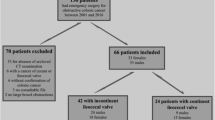Abstract.
Surgical treatment of carcinoma of the distal third of the rectum with anal sphincter preservation is increasingly used in accredited cancer centers. This study aimed to evaluate the diagnostic usefulness of radiological investigations in the management of patients who had undergone resection with coloanal anastomosis for carcinoma of the rectum, in the immediate post-operative period, during closure of the protective colostomy and in the follow-up of symptomatic recanalized patients. A total of 175 patients who had undergone total rectal resection with end-to-side anastomosis for carcinoma of the distal third of the rectal ampulla, most of whom had received postoperative radiotherapy, were evaluated radiologically. In the postoperative period radiological investigation was ordered only for symptomatic patients to detect pathology of the anastomosis and the pouch sutures and was used direct film abdominal radiography and contrast-enhanced radiography of the rectal stump with a water-soluble radio-opaque agent. Before closure of the colostomy, 2 months after rectal excision or approximately 4 months after if postoperative radiotherapy was given, the anastomosis and pouch of all patients, even asymptomatic ones, were studied with water-soluble contrast enema to check for normal canalization. In the follow-up after recanalization radiological examinations were done to complete the study of the large intestine if the endoscopist was not able to examine it up to the cecum. Of the 175 patients examined radiologically during the postoperative period and/or subsequent follow-up, 95 showed no pathological findings. Seventy-nine patients had fistulas of the coloanal anastomosis or the pouch, 23 of which supplied a presacral collection. In the absence of severe sepsis, the only therapeutic measures were systemic antibiotics and washing of the surgical catheters to maintain efficient operation. In 2 patients in whom transanal drainage was performed radiologically the fistula was cured in 1 week. In 36 cases of cicatricial stenosis, 17 at the coloanal anastomosis and 19 at the pouch, radiological examination always detected the lesion, correctly defining its anatomical characteristics, nature and extension. Of the 19 cases of stenosis treated radiologically, 15 recovered an adequate intestinal calibre for normal evacuation. During follow-up of the 175 patients operated on, 21 cases of recurrence were detected. Radiological examination was requested as the first investigation in only one of these cases, for a patient with subocclusion. Radiological investigations in patients who have undergone coloanal anastomosis are of real diagnostic value in the immediate post-operative period, during closure of the protective colostomy and in the follow-up of symptomatic recanalized patients.
Similar content being viewed by others
Author information
Authors and Affiliations
Additional information
Received: 8 February 1999; Revised: 14 June 1999; Accepted: 27 August 1999
Rights and permissions
About this article
Cite this article
Severini, A., Civelli, E., Uslenghi, E. et al. Diagnostic and interventional radiology in the post-operative period and follow-up of patients after rectal resection with coloanal anastomosis. Eur Radiol 10, 1101–1105 (2000). https://doi.org/10.1007/s003309900185
Issue Date:
DOI: https://doi.org/10.1007/s003309900185




